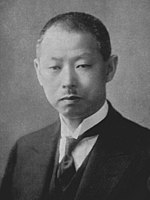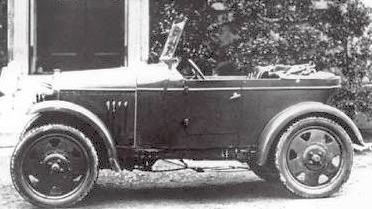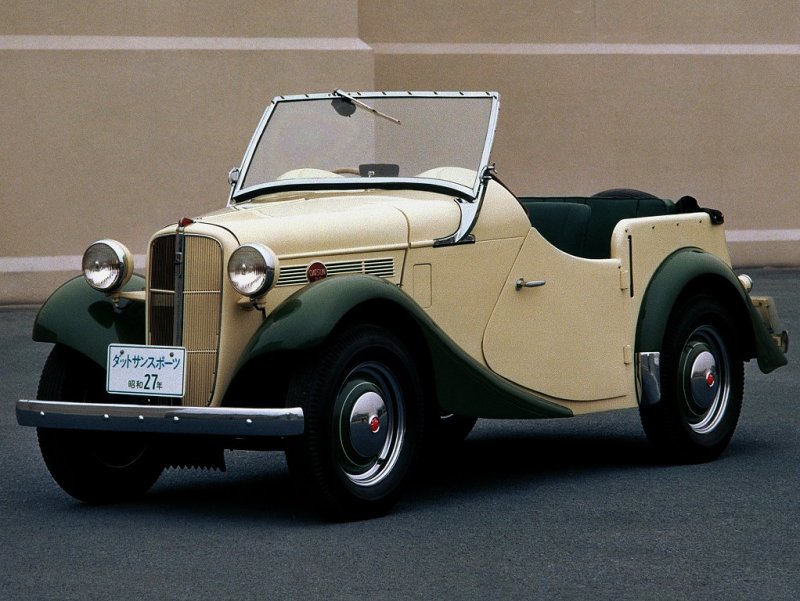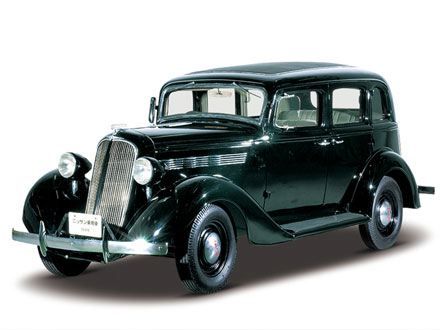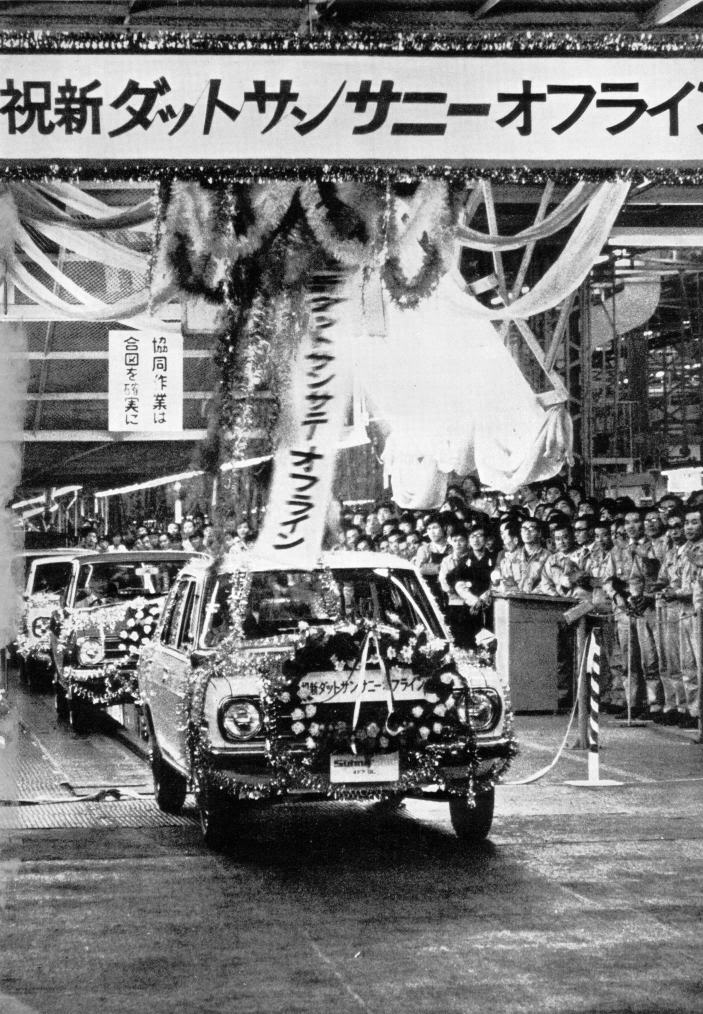The Datsun brand of cars came out of the merger of two early Japan car companies, DAT Automobile Co. and Jitsuyo Automobile Co. This new company DAT Automobile Manufacturing Co. eventually created the Datsun brand. Shortly after the first Datsun was produced in 1931, the fledgling Nippon Sangyo holding company, desiring to enter the automobile business, takes over DAT in 1933. The next year Nippon Sangyo names the car company Nissan Motors. The rest is history and today the company is known as Nissan Motor Co., Ltd (日産自動車株式会社).
Kwaishinsha
1911 July 1: 橋本増治郎 (Masujiro Hashimoto) forms 快進社 (Kaishinsha or 'Advanced Car') in Azabu district of Tokyo, with backers of Den, Aoyama and Takeuichi. The initials DAT are eventually applied to name the car project.
Masujiro Hashimoto

1912: Hashimoto builds first prototype DAT automobile. In Japanese DAT (pronounced 'datto') is 脱兎, which means 'bounding away (with lightning speed), so it is fitting for a young company's automobile hopes.
1913 October: Second car, the DAT 1, is created
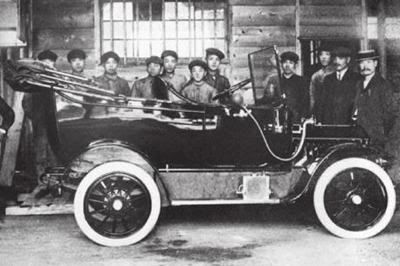
Masujiro Hashimoto is on far right
1914 March: DAT 1 wins a Bronze Medal prize at Tokyo Taisho Expo
- V2 engine two-cylinder v-formation
- 10 HP, top speed 32kph
1914: 快進自動車工場 (Kwaishinsha Automobile Works) is established in Tokyo. Apparently it is the first automobile manufacturer registered with the Japanese government. 快進自動車工場 literally means 'advanced car factory'.
1915: DAT 31 birth, with 2-liter 4-cylinder engine fitting
1916: DAT 41 birth, with bored 2.3-liter engine, 15 HP. Produced until 1926.
1918 August: Reorganized as Kwaishinsha Automobile Co., Ltd. (株式会社 快進社, KK Kaishinsha) with a capital of 600,000 Yen. The purpose was to sell the first generation DAT 41, a full-size five-passenger car for wealthy customers.
Jitsuyo
1919: Kubota (the tractor company) forms a subsidiary to manufacture cars, named it 實用自動車 (Jitsuyo Automobiles) in Osaka. American William R. Gorham previously had approached Kubota with a design for a design for a two passenger three-wheeled car powered by Harley-Davidson motorcycle engine. This is at the time of motorcycle mania around the world.
Yumito Kushibiki and William R. Gorham

1919 December 5: Gonshiro Kuboto, company head, creates Jitsuyo with W.R. Gorham as Chief Engineer and 1,000,000 Yen capitalization.
1919 October: Jitsuyo's first product is the small three-wheeled 'Gorham' car. Production of Gorham 3-wheeler is about 30 units per month. About 150 Gorhams are sold.
- V2 air-cooled engine
- 7 HP rating
- Simple friction drive
- Tiller steering
1921 October 24: Gorham 1 car ended (3-wheeler)
1921 November: William R. Gorham and engineer 後藤敬義 (Takayoshi Goto) completes a four-wheel car design by converting the Gorham to four wheels, but then Gorham leaves Jitsuyo to work for Tobata Castings. About 100 of these cars are sold.
1921: Takayoshi Goto creates the Lila Light Car, based on a rework of Gorham's original design.
- production from 1922-1926, about 200 cars total production
- 10 HP, top speed 30 mph
- both car and truck models offered
- popular in Tokyo taxi market due to narrow 40-inch track
1923: 1st Lila completed. It has rear wheel differential drive. It is difficult to complete with Ford and GM, which are building cars in Japan.
1924: Lila modified for worm gear steering by Goto, replacing tiller steering of previous units.
1925: Jitsuyo in difficult situation, repairing Kubota tractors and GM cars in attempt to survive.
DAT Co.
1925: 株式会社 快進社 (KK Kwaishinsha) is reorganized as 合資会社 ダット自動車商会 (DAT Automobile Co., Ltd.)
Merger of DAT and Jitsuyo
1926 September 2: DAT and Jitsuyo merge, to form ダット自動車製造株式会社 (DAT Automobile Manufacturing Co.,). Headquarters are in Osaka. Jitsuyo, in the face of intense competition from Ford and GM in Japan, was only selling about 150 cars per year. It barely survived by taking on work from Kubota and even GM. Therefore a merger with DAT was sought. DAT had military truck contracts, so was in better condition than Jitsuyo.
1928: DAT 91 planned (500cc class)
1929: DAT 91 experimental testing
1930 August: Second DAT 91 prototype completed
1930: By 1930, 137 units of DAT 41, DAT 51, and DAT 61 have been produced.
1930: Datson is born by Engineer 後藤敬義 (Takayoshi Gotou)
1930: DAT 91 small car design (Datson) completed, with 500cc engine fitting. Production is intended.
Nippon Sangyo
1928: 鮎川義介(Yoshisuke Aikawa) founds the holding company Nippon Sangyo (Japan/Nippon Industries). Aikawa's passion is mass-producting autos, and this fledging company soon begins buying or taking over other established companies.
Takeover of DAT
1931: Nippon Sangyo controls foundries and auto parts businesses, but no automobile manufacturing. Aikawa Yoshisuke purchases controlling shares in DAT Motors
1931 June: 戸畑鋳物株式会社 自動車部 (Tobata Casting Co., Ltd. Automotive Division), affiliated with Tobata Casting. Headquarters: Fukuoka Prefecture, President: Ayukawa Yoshisuke.
First Datsun
1931 August: DAT comes out with a new smaller car, the first Datson, meaning 'Son of DAT'. It is a two-passenger car.
Nissan Short Story: Birth of Datsun☁
The 1931 prototype DAT-91 with its Lincoln hood ornament was developed by DAT

- First Datson, model DAT 91 aka Type 10 and advertising mark
- About 10 were sold
Datson brochure by DAT proclaims the "production Datson": the small car

ダット自動車製造株式会社
大 阪 ・ 東 京
DAT Automobile Manufacturing Co.
Osaka ・ Tokyo
Early version? Back says DAT Automobile Co.

Later version? Dealer stamp on back says "Datsun Automobile Trading Company"
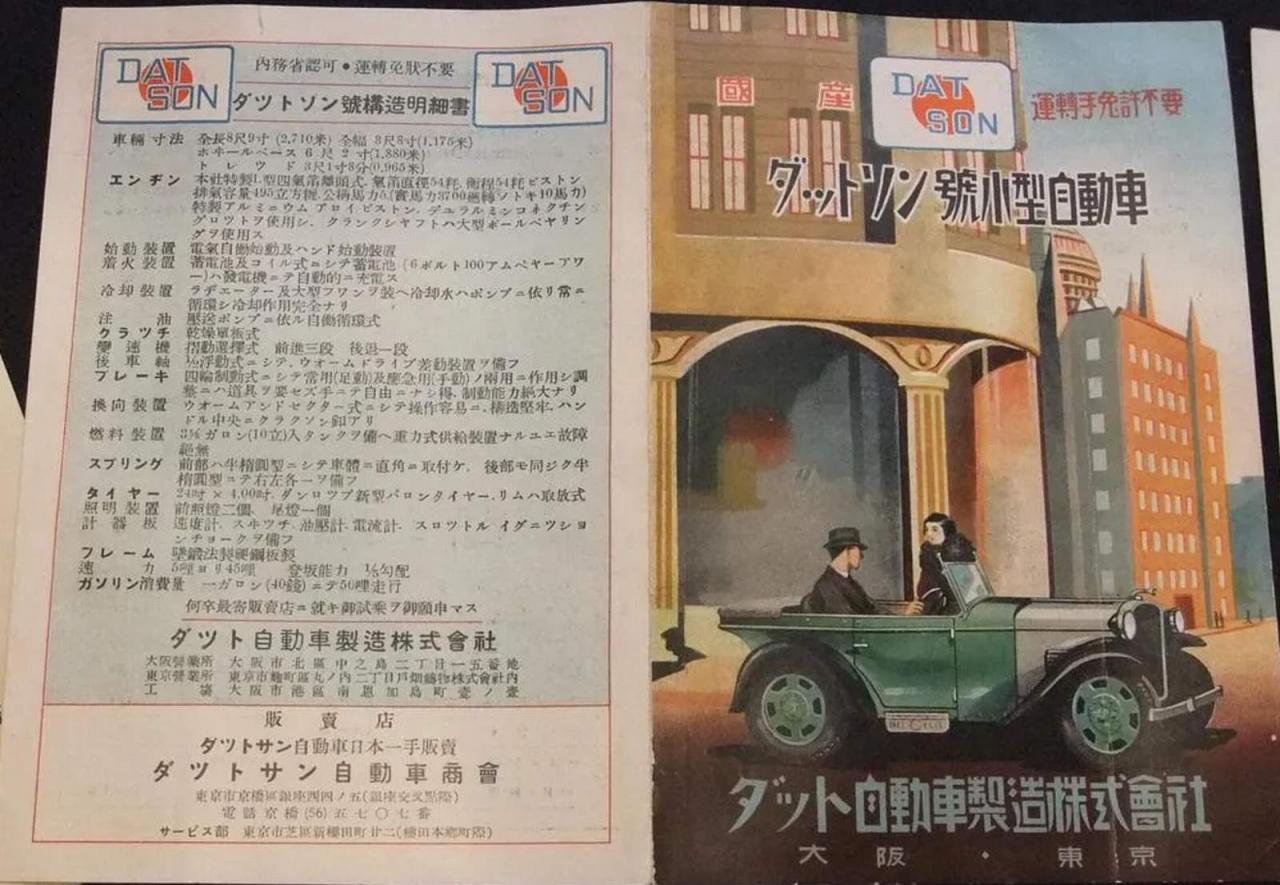

~~ 1931: Nissan takes control of DAT
1932 March: Datson mark is renamed Datsun, a more harmonious spelling. Reportedly though perhaps apocryphal, a common story is that after the DAT factory was victimized by flooding during a typhoon, it was attributed to the 'son' in Datson ('son' in Japanese means 'loss'). So the spelling was altered to be more positive. Whatever the impetus, the spelling was changed to 'sun'. Interestingly it fits with the Japanese 'sun' flag logo shown on the 1931 Datson catalog. Sun has no particular meaning in Japanese, except that it is pronounced 'san'. Nominally, san is a title of respect, roughly equivalent to the English Mr. or Mrs.
The Datsun mark, with red, white and blue sections, is created by 吉崎良造 (Yoshizaki Ryouzou) and 田中常三郎 (Tanaka Tsunesaburou). They are inspired by the early Chevrolet mark, such as this 1918 example. The white background red round portion represents Hinomaru (sun disc), Japan's white national Flag with red sun (morning rising sun). The cobalt blue section represents the sky.

1932 April 15: Datsun 自動車商会 (Automobile Chamber of Commerce) established
Datsun Type 11
The first car to use the new spelling 'Datsun' is the 1932 Datsun Type 11.
- 1931-style wide metal spoke wheels
- 1931-style upswept rear body
- 1932-style bonnet louvers
- seat forward of rear wheel
- 1932 Datsun Type 12 Phaeton
- 1932 production: ~150
- Sedan weight: 400 kg, Overall length: 2710mm, Width: 1175mm, Tire Size: 24'x4', Wheelbase: 1880mm, Track: 965mm
- Made in Osaka
- Engine: 747cc, 56mm bore × 76mm stroke, 12PS @ 3000 rpm, top speed 65kph
During this time, reportedly, Lord Austin in the UK (the head of the Austin car manufacturer) heard that the Datsun was a copy of the Austin 7. The book 'Car Wars' says Austin had a Datsun obtained in Japan, shipped to England and gone over with a fine tooth comb. The result? Austin could not find anything to sue over. Some say the size, design and engine look similar to the Austin 7, however the engine is much smaller and the car design has significant differences from the Austin 7. We may conclude, that as with many cars around the world at that time, the Austin 7 probably influenced the design of the Datsun but that the Datsun was not a copy.
1933: Aikwawa merges Tobata Casting's automobile parts department with DAT Automobile. The Company is renamed 自動車製造株式会社 (Jidosha-Seizou Kabushika Kaisha [KK, meaning Co., Ltd.])
DAT truck production is separated off and merged with Ishikawajima and TGE, the new company being named (Tokyo Jidosha Kogyo). It will eventually be named Isuzu.
1933 March 1: 日 石川島 (Ishikawajima) Ishikawajima and merger, 自動車工業 (Automotive Industry) (Corporation) established
1933 August 18: Small car regulation expanded to 750cc
1933 September 22: Tobata Casting removal of Datsun manufacturing license (from Automotive Industry)
1933 November 1: 495cc to 747cc conversion
1933 December 6: 自動車製造 (Auto Worker) Corp. established
Nissan
1934: Aikawa 'separated the expanded automobile parts division of Tobata Casting and incorporated it as a new subsidiary, which he named Nissan Motor (Nissan)'. This is 日産自動車 (Nissan Motors).
1934 June 1: Renamed to 日産自動車 (Nissan Motor Co.)
1934 June: The shareholders of the new company however are not enthusiastic about the prospects of the automobile in Japan, so Aikawa buys out all the Tobata Casting shareholders (using capital from Nippon Sangyo). At this time Nissan Motors effectively becomes owned by Nippon Sangyo and Hitachi.
1934: 880 Datsuns produced, 44 units exported
1934: New Yokohama plant is being built. Aikawa, with William R. Gorham as technical advisor, is building the largest automobile manufacturing factory in Japan. They purchase entire production lines from the troubled american Graham-Paige company, including production tools and truck designs. Import/Export specialist Mitsubishi is engaged to import the american equipment into Japan. Do to this expansion and modern tooling, DAT gets advantage over all other Japan car producers.
Datsun Type 13
1934 September: Datsun Type 13 birth. It is still a two-passenger car.
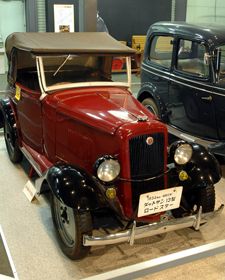
- Datsun Type 13 Roadster
- Overall length: 2800mm, width: 1200mm, height: 1450mm, top speed: 65kph, weight: 500kg
- four sedan models squaring, coupe, phaeton, roadster, van, and the truck was manufactured
Datsun Type 14
The Datsun Type 14 was the first four-passenger Datsun.

1935 April: First Datsun rolls out of new Yokohama factory, a new design Datsun Type 14
The Datsun Type 14 is a four-seater: 'Beautifully streamlined compact car. The favorite of the day. One for every family.'


rabbit mascot created by body designer Ryuichi Tomiya.
- Rabbit: 兎
- DAT: 脱兎 (pronounced 'datto') meaning 'dashing away', 'bounding away' or 'with lightning speed'
- Perhaps inspired by the leaping hound mascot placed on the original Datsun 10 prototype. From factory photos, it was clearly an off-the-shelf Lincoln part. The hare mascot though was all-Datsun and a thing of beauty.
- Note the squeeze-bulb horn visible under the steering wheel
- Overall length: 2790mm, Width 1190mm, Height 1600mm, Top speed 80kph
- 3800 produced
- Can you drive without a license (750cc car, driver's license is not required)
- 1935 53 units exported
- Datsun Type 14 Sedan Price: 1,900 yen (Yokohama ex)
- Compare to the then 75 yen starting salary for civil servants
Type 14 Sedan | Type 14 Roadster


The Datsun Type 14 featured the L engine, a four-cylinder overhead valve design.

722cc engine fitting, 15HP
Type 14 Roadster Photo Gallery at Response.jp
1935: Nissan has impressive advertising campaign to highlight their superior compact car. Time Magazine features Datsun in article, although Datsuns will not be sold in america until 1958

Shipments Already Are Being Made to Australia and South Africa
Datsun Type 15
1936: Datsun Type 15 birth
1936: 87 units exported
Datsun Type 16
1937 April: Datsun Type 16 birth

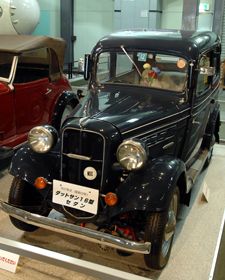
- 1937 Datsun Type 16 Sedan
- Overall length: 3120mm, width: 1200mm, height: 1600mm, top speed: 80kph, weight: 610kg
Datsun Sport
Shouwa 27 = 1952
Nissan Branded Vehicles
1937: First Nissan-branded car introduced, the Nissan Type 70, created with with American Graham-Paigeᵂ production line design
Nissan Type 70 Phaeton, 1938 model
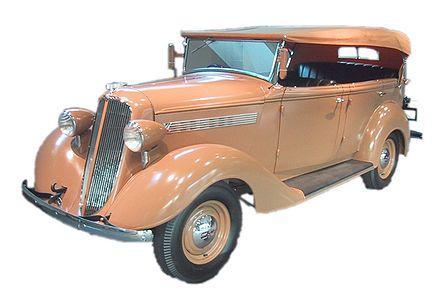
NISSAN delivery van, based on Graham-Paige truck designs puchased by Nissan

NISSAN with 3670cc six-cylinder engine in 三越 (Mitsukoshi) department store livery
Wartime
1938: All car production in Japan is halted.
1940s: Nippon Sangyo, now popularly known as 日産 (Nissan), becomes the famous Nissan 'Zaibatsu' (combine) including Tobata Casting and Hitachi. It grows to include 74 firms, and to be the fourth-largest combine in Japan during the wartime years.
1947: For two years (1947 to 1948) the company was briefly called Nissan Heavy Industries Corp.
1951 May: Datsun DB-2 launched with an 860cc, 20hp engine
1952 January: Datsun Sports DC-3
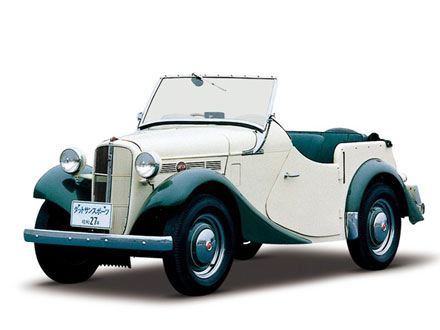
- Body by Y. Ohta
- DC-3 Production: 50 cars
Nissan and Austin
1952: In the postwar era, like Hino and Isuzu, but unlike Toyota, Nissan partnered with an established European company to gain access to automobile and engine designs. Nissan chose Austin of the United Kingdom. They entered into a well-documented legal agreement with Austin, for Nissan to assemble 2,000 Austins from imported partially assembled sets and sell them in Japan under the Austin trademark.

Caption: December 1952, Nissan has launched a technology alliance with Austin, in 1953 began production in April to assemble A40 from knock-down. The engine is 1200cc 42HP. Sale price was 112 yen in Tokyo.
The agreement called for Nissan to make all Austin parts locally within three years, a goal Nissan met. Nissan produced and marketed Austins for seven years. The agreement also gave Nissan rights to use Austin patents, which Nissan used in developing its own engines for its Datsun line of cars. In 1953 British-built Austins were assembled and sold, but by 1955, the Austin A50 -- completely built by Nissan and featuring a slightly larger body with new 1489 cc engine -- was on the market in Japan.
Nissan produced 20,855 Austins from 1953-1959.
1953 April 4: production birth Austin A40 by Nissan at Tsurumi Austin factory. From the start of production, domestically produced tires, batteries, and flat glass were used.
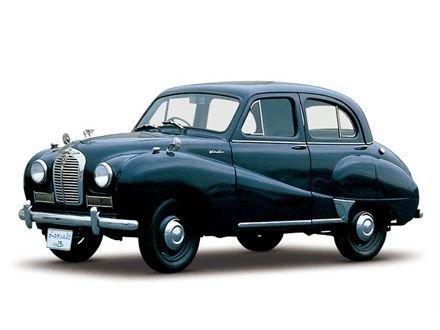
Austin A40 Somerset Saloon by Nissan
1953 May 8: Commemorative launch event of Austin production held in Tsurumi, with guests including the Trade & Industry Minister and the British Ambassador.

Austin A50 Somerset Saloon by Nissan
Caption: The domestic A40 > A50 companion made by Nissan with the February 1955 A50 issue. And the sealing from three years and nine months completed their domestic production, the mission closed in February 1960 at the creation of Cedric. 1500cc 50HP gain.
Engine Technology
As as a result of Nissan manufacturing and license of Austins, Nissan leveraged the Austin patents to further develop their own modern engine designs past what the Austin's A- and B-family designs offered. The apex of the Austin-derived engines was the new design A series engine in 1966.
For developing the 1000cc engine (C Type) for the 1957 Datsun 110 — under the advice of American engineers, Donald Stoneᴳ was enrolled at Nissan. He was formerly at Willys-Overland. The C engine was derived from the production Austin A50 Cambridge license. He destroked the BMC B series 1500 engineᵂ, and the resulting C engine was called the "Stone engine". When it was later increased to 1.2 liters for the first Bluebird (Datsun 310) it was named the E1 engine.
Why did Datsun modify the Austin engine to be smaller? The Austin B-series 4-cylinder engine was available in sizes from 1.2 liter to 1.8 liter. This was too big for the Japan small-car tax class, where a 1000 cc engine was needed. Hence Stone's destroking ideas were applied and set Datsun on the road to dominance, becoming the top-selling Japan auto maker by the late 1960s.
Datsun Sunny
1966: Datsun Sunny birth with all-new 1000cc aluminum-head Nissan A Engine.

Datsun 1000 'Sunny'
1970 January: Datsun Sunny 1200 birth
- See main article: History of Datsun 1200
End of Datsun Brand
1981-1983: After becoming one of the world's great brand names, Datsun brand name is globably replaced with Nissan badging. This was to achieve greater recognition for the Company (Nissan) rather than the better-known Brand (Datsun).
1989 November: Japan model Datsun 1200 pickup, lacking Datsun badges for some years, is formally badged as a Nissan
Datsun Name Continued in Japan
1984-1985: Datsun continues to be used as a model name in Japan for the 720 truck
1985-1997: Datsun name used as a model name in Japan for D21 pickups (known as Navara or Harbody in other countries).

2002 D22 Datsun Truck (1997-2002)


D22 "Datsun Truck" production ends in Japan March 2012. See Datsun Truck - Wikipedia Japanese
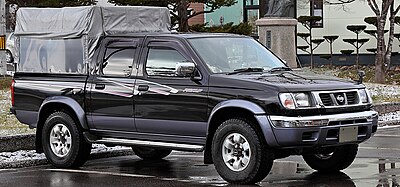
End of Datsun 1200 Line
1994: Nissan ends production of Datsun 1200 pickup (now called Nissan Sunny Truck) in Japan.
- See main article: B120
2007 November: Nissan South Africa ceases production of the Datsun 1200-bodied based Nissan LDV 1400 small pickup.
- See main article: B140
See Also
See: * Datsun History - Australia * History of Datsun 1200
References
- http://www.nissan-global.com History section
- Cusumano, Michael A. (1985). The Japanese Automobile Industry. Harvard University Press. ISBN 0-674-47255-1
- Rae, John B. (1982). Nissan/Datsun: A History of Nissan Motor Corporation in U.S.A., 1960-1980. McGraw-Hill Book Company. ISBN 0-07-051112-8
- (1983) Fifty Years of Datsun. CG Car Books 雑誌コード64303-04 ISBN 4-544-09185-3

![[Datsun 1200 encyclopedia]](/wiki/upload/wiki.png)


